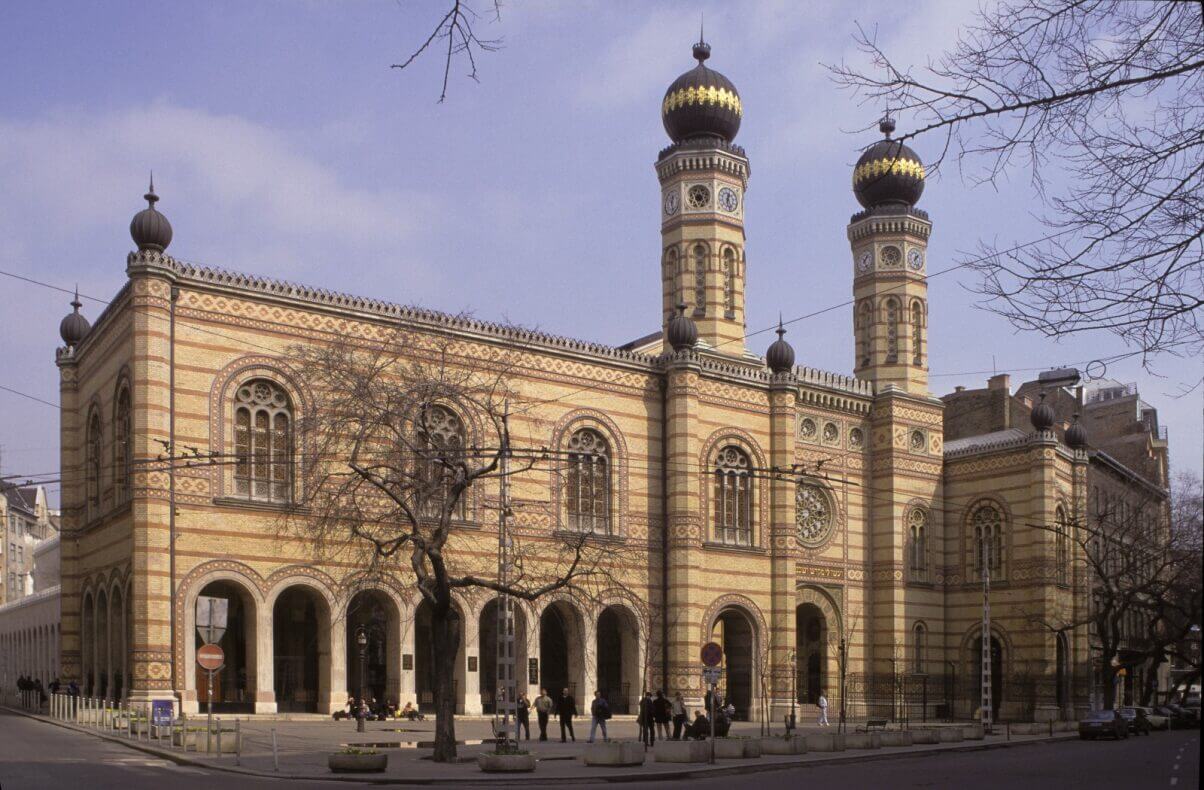This website uses cookies so that we can provide you with the best user experience possible. Cookie information is stored in your browser and performs functions such as recognising you when you return to our website and helping our team to understand which sections of the website you find most interesting and useful.
Dohány Street Synagogue Complex

The EHL Site
The Dohány Street Synagogue is located in the centre of the Jewish quarter of Budapest, in the 7th district, Erzsébetváros. The nave is 53.1 metres long, the two towers are 43.6 metres high, the interior is 1200 m2 and has 2,964 seats. Between 1929 and 1931 the building underwent a minor renovation, during which time the Jewish Museum and the Temple of the Heroes were built, as well as a grassy garden surrounded by a colonnade. In 1944 one of the gates of the ghetto was on the Wesselényi Street side of the arcade. The other parts of the complex are Dohány Street 2-4 (the building of the Hungarian Jewish Museum and Archives, the Synagogue of Heroes, and Síp Street 12 – Wesselényi Street 7 (the building of the headquarters of the Jewish Community and the Goldmark Hall. All the properties are listed monuments. The Heroes’ Synagogue commemorates the 10,000th Hungarian Jewish soldier who died defending their homeland in World War I. Of particular importance are the synagogue garden, which became a cemetery for Holocaust victims in 1944-45, and the Wallenberg Memorial Park, located between the synagogue and the headquarters, the centrepiece of which is the memorial tree erected by the Emmanuel Foundation of Hungary in 1988. The complex is located in the protection zone of the Budapest World Heritage Site.
European dimension
The synagogue is a symbolic building of the neologism movement. The synagogue is historically significant as the largest synagogue in Europe and the third-largest in the world. It was built in the mid-19th century and has served as a symbol of the thriving Jewish community in Budapest. The roots of neology, which exists only in Hungary, can be traced back to the work of the Chief Rabbi of Arad, Áron Chorin. Neology combines at the same time the traditional Jewish liturgy, the spirit of the Hungarian civilisation and some external elements of the Reform. As the Dohány Street Synagogue is the only synagogue that contains all the elements of Jewish trends, Jews from all over Europe and the world feel it as their own. Throughout the existence of the the Jewish Theological Seminary – University of Jewish Studies in Hungary, the rabbis of the Dohány Street Synagogue played a significant role in the training of rabbis. Many of the former graduates have been appointed rabbis in European countries (e.g. Germany, Czech Republic, Switzerland, England, Romania). The community of Dohány Street Synagogue is still in contact with the Jewish communities of other EU Member States (Czech Republic, Italy, Austria). After walking through the spaces of the Synagogue Complex, the visitor realises that the values of neology and integration are universal values: in addition to respect for one’s own culture and traditions, tolerant thinking open to the heritage of other groups in society can prevent exclusion and achieve social peace.
The organization
The Federation of Jewish Communities in Hungary and its member community, the Budapest Jewish Community (the largest in Central Europe), is constantly organising programmes and actively initiating cross-border contacts. The largest cultural event organised by the Jewish Community of Budapest is a series of events called the Jewish Cultural Festival, which brings performers from all over Europe to the Dohány Street Synagogue and the nearby Rumbach Synagogue.
The synagogue is regularly used by artists from Hungary and other EU Member States for major concerts – with maximum respect for religious considerations. This is already a way of encouraging intercultural dialogue as a Jewish sacred site, as many of the renowned artists who perform here are brought to the synagogue. The Hungarian Jewish Museum and Archives (HJMA) collects, processes scientifically, makes researchable, carefully preserves and nurtures, and – for the sake of individual and community culture – makes Hungarian Jewish cultural values known to the widest possible audience balancing between cultural heritage protection and tradition.
As a dynamically developing, well-known Jewish cultural institution in Hungary, HJMA promotes dialogue between the Jewish community and the non-Jewish population, forming an open, visitor-friendly service and meeting place. Our permanent exhibition presents the cornerstones of Judaism: ordinary days, holidays and major life cycle events in Judaism.
In the course of past centuries a rich object culture developed with a view of providing interpretation of Jewish written heritage and to be passed down from generation to generation. This exhibition showcases a selection of ceremonial objects, books and furniture from our collection. Some of the objects and documents belonging to the collection are particularly sensitive materials, which must be preserved, processed and published with special care. In our practice, this primarily concerns the proper placement and handling of sacred texts (geniza, ensuring the dignity of exhibited materials), as well as working with documents and images related to Holocaust that may offend the human dignity of the Jewish people.
